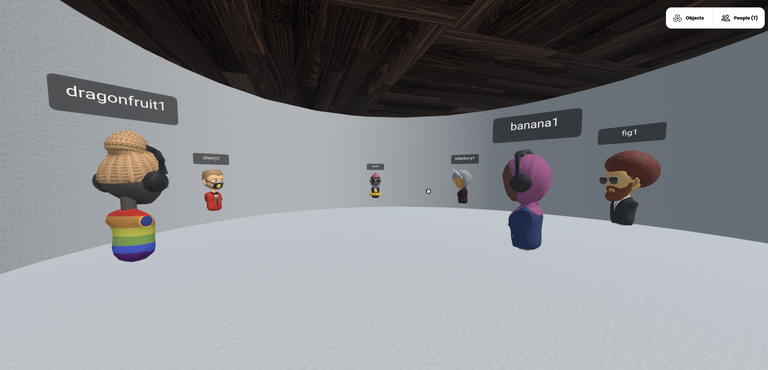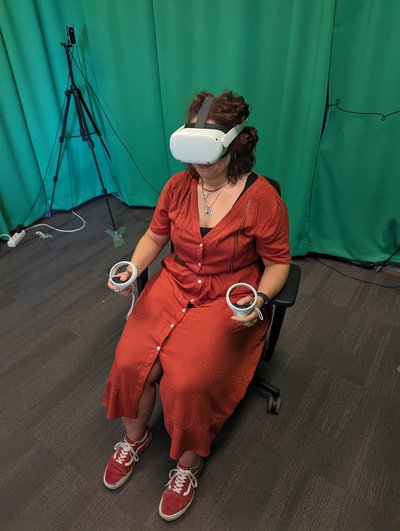"In a moment, each of you will be taken to a separate room. When you put on your VR glasses there, you will end up in an empty room where you will perform two tasks." With this instruction, our six-member group leaves for the rooms, where we teleport ourselves into a small circle via controllers. The glasses reveal an austere virtual reality, where we do not see each other's faces, but randomly chosen avatars. From the first second, things get uncomfortable. We end up randomly in the circle, sometimes literally right in front of each other's noses. Automatically I recoil at this violation of my personal space. Only to end up in someone else's personal space. One of the participants suggests standing in a circle. Once everyone has found their place, we begin the first task.
How do we use space in VR?
Our researchers try to make the VR world a better place. With technology improving fast, they are tackling some of the main challenges in their area. This series addresses a couple of these challenges. Part 2: personal space and navigation.

Meanwhile, researcher Silvia Rossi (https://www.silviarossi.nl) of the Distributed and Interactive Systems (DIS) group has already gained a lot of valuable information. She is investigating what in technical jargon is called spatial arrangement: "How do people feel in a virtual environment? In this experiment, I want to find out how the size of the space affects the behaviour of VR users. And what does this do to their comfort?"
Ideal size
"In the real world, the distance you keep from others varies," Rossi explains. "It is much smaller with family or your partner than with colleagues and people you don't know. In the VR world it works in the same way. Previous research with avatars shows that there, too, roughly the same distances are maintained."
With her study, Rossi goes a step further: does it matter how big the room is when you are there with people you don't know? How comfortable do you feel standing in a small space with strangers? "We measure this using a questionnaire about the quality of the experience, followed by interviews with the participants. We also measure where in the space people stand most often and exactly how much distance they keep from others. This helps designers arrive at an 'ideal' size of the space to create in VR. You could, of course, create a space that is more than big enough. But that takes an awful lot of time, money and computer memory because you have to design each detail separately."
Rossi deliberately used an empty space, in which only the avatars of the others could be seen. "Furniture and paintings can in fact influence the experience. But I can imagine future research taking that into account. Then you take measurements in an office environment or a more natural habitat, for example."

Psychology
There is a lot of literature on the distance people keep from each other in all kinds of situations - that kind of psychological research dates back well before the introduction of virtual reality. In 2021, DIS group leader Pablo César projected existing theory on the subject onto VR [1[i]]. Why only so recently? Rossi: "First the focus was mainly on the technology, getting it right. Now the users' experience is becoming more important.
That shift means VR is being looked at from a different angle. "I mix tools from different fields that are sometimes far outside my expertise. My background is electronic and telecommunication engineering. For the research I delved into the psychology literature and for my previous study I applied measurement methods that you normally use to measure human mobility."
Moving through space
Parallel to this study, Rossi is trying to predict how people move within the virtual world when they watch a 360-degree video through VR glasses. Such an experience completely immerses them in what they see - as if they themselves were on a rollercoaster or diving into the sea. "I'm trying to understand how people navigate through content.”
"By now we know that what people do in the virtual space depends on their personality and background [2[ii]]. So we can have a totally passive consumer, who navigates statically and just lets everything happen to them. And a more random navigator: someone who decides for themselves what they want to look at and from which angle, and clicks away. I am developing an algorithm that learns and predicts whether someone navigates statically or randomly. Predicting the navigation style is important to prevent image faltering that causes the environment to not react immediately to your actions, but keeps lagging behind. If you manage to predict which path someone will take, you can send content ahead of time to active viewers."
[i]Julie Williamson, Jie Li, Vinoba Vinayagamoorthy, David A. Shamma, and Pablo Cesar. 2021. Proxemics and Social Interactions in an Instrumented Virtual Reality Workshop. In Proceedings of the 2021 CHI Conference on Human Factors in Computing Systems (CHI '21). Association for Computing Machinery, New York, NY, USA, Article 253, 1–13. https://doi.org/10.1145/3411764.3445729
[ii] Silvia Rossi, Irene Viola, and Pablo Cesar. 2022. Behavioural Analysis in a 6-DoF VR System: Influence of Content, Quality and User Disposition. In Proceedings of the 1st Workshop on Interactive eXtended Reality (IXR '22). Association for Computing Machinery, New York, NY, USA, 3–10. https://doi.org/10.1145/3552483.3556454
Read part 1 of this series: Only a heartbeat away
